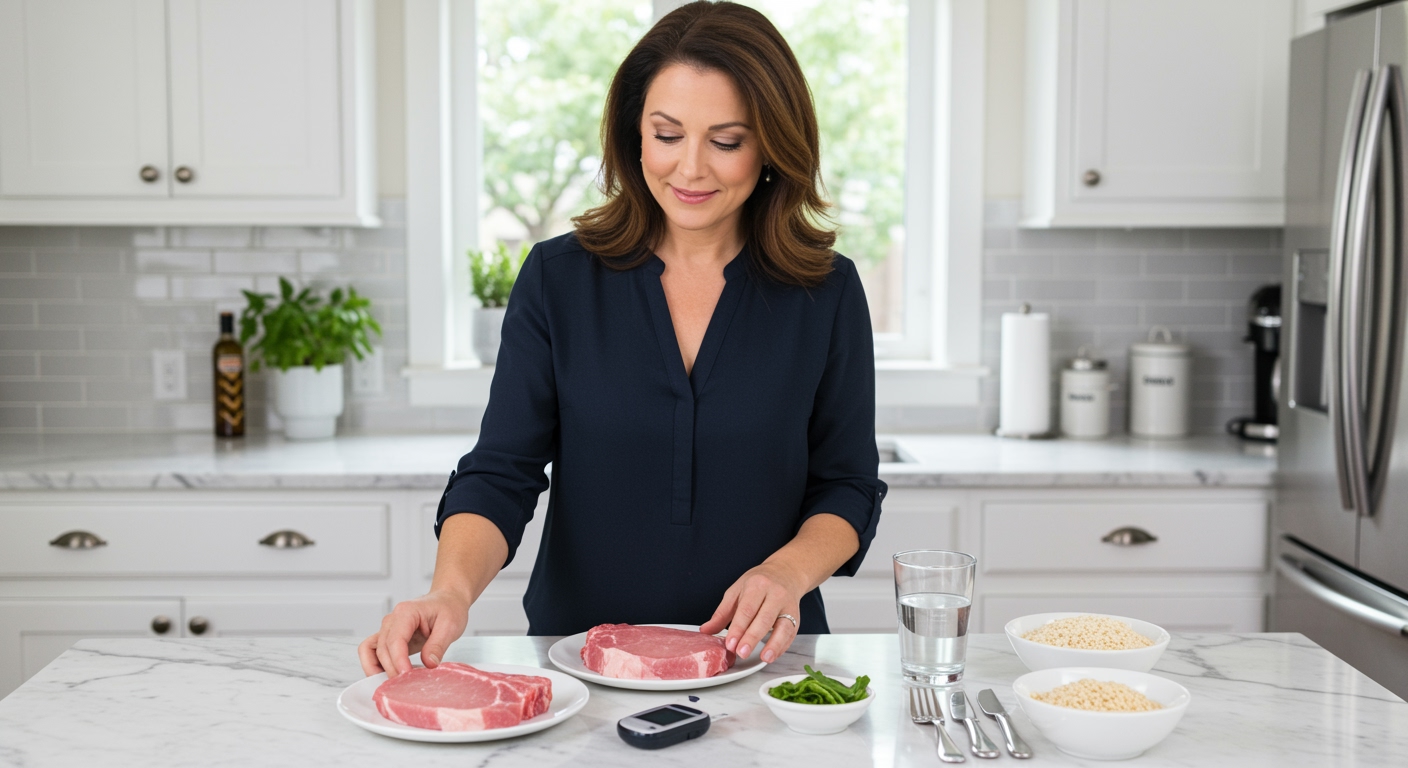✪ Key Takeaway: Pork chops are generally safe for diabetes when eaten in proper portions without sugary marinades or breading.
Introduction
You stare at that juicy pork chop on your plate and wonder if it will send your blood sugar through the roof.
This question haunts many people with diabetes who want to enjoy their favorite proteins without compromising their health.
Hi, I am Abdur, your nutrition coach and today I am going to explain everything you need to know about pork chops and diabetes management.
How Does Pork Chop Affect Blood Sugar Levels?
Pork chops have a glycemic index of zero because they contain virtually no carbohydrates.
This means plain pork chops will not cause a direct spike in your blood glucose levels.
The protein content in pork chops actually helps stabilize blood sugar by slowing down the absorption of any carbohydrates you eat with your meal.
A typical 3-ounce pork chop contains about 22 grams of protein and zero grams of carbohydrates.
However, the cooking method and added ingredients can dramatically change this equation.
Breaded pork chops or those marinated in sugary sauces will contain significant carbohydrates that can raise blood sugar levels.
✪ Fact: Plain pork contains less than 1 gram of carbohydrates per 100-gram serving.
What Nutrients Do Pork Chops Provide For Diabetics?
Pork chops offer several essential nutrients that benefit people with diabetes.
They provide high-quality complete protein that helps maintain muscle mass and supports steady blood sugar control.
Pork is rich in B vitamins, particularly thiamine, niacin, and vitamin B6, which play crucial roles in glucose metabolism.
These vitamins help your body convert food into energy more efficiently and support proper nerve function.
Pork chops also contain selenium, a powerful antioxidant that may help reduce inflammation associated with diabetes complications.
The zinc content in pork supports immune function and wound healing, both important for people managing diabetes.
Additionally, pork provides phosphorus for bone health and potassium for heart function.
✪ Pro Tip: Choose lean cuts like tenderloin or center-cut chops to maximize protein while minimizing saturated fat.
Are There Any Risks Of Eating Pork Chops With Diabetes?
The main concern with pork chops for diabetics is their saturated fat content, not their effect on blood sugar.
People with diabetes have a higher risk of heart disease, and excessive saturated fat can worsen this risk.
A 3-ounce pork chop contains about 3-4 grams of saturated fat, which is moderate but should be considered within your daily limit.
Processed pork products like bacon or sausage pose greater risks due to their high sodium and preservative content.
Some studies suggest that regular consumption of red meat may increase insulin resistance over time.
However, occasional consumption of lean pork chops as part of a balanced diet is generally considered safe for most people with diabetes.
The key is portion control and choosing preparation methods that do not add unnecessary calories or carbohydrates.
✪ Note: Limit red meat consumption to 2-3 servings per week and balance with fish, poultry, and plant proteins.
What Is The Best Way To Prepare Pork Chops For Diabetes?
Grilling, baking, or broiling are the healthiest cooking methods for pork chops when you have diabetes.
These methods allow excess fat to drain away while preserving the protein content.
Avoid breading or battering your pork chops, as this adds unnecessary carbohydrates that will raise blood sugar levels.
Season your pork chops with herbs and spices instead of sugary marinades or sauces.
Garlic, rosemary, thyme, and black pepper add flavor without affecting blood glucose.
If you want to marinate your pork chops, use olive oil, vinegar, and herbs rather than commercial marinades that often contain added sugars.
Pair your pork chop with non-starchy vegetables and a small portion of complex carbohydrates like quinoa or sweet potato to create a balanced meal.
✪ Pro Tip: Use a meat thermometer to ensure pork reaches 145°F internal temperature for food safety without overcooking.
How Much Pork Chop Can You Eat With Diabetes?
A proper serving size of pork chop for someone with diabetes is about 3-4 ounces, roughly the size of your palm.
This portion provides adequate protein without excessive calories or saturated fat.
Most people with diabetes can safely enjoy pork chops 2-3 times per week as part of a varied protein rotation.
The timing of your pork chop consumption can also impact blood sugar control.
Eating protein-rich foods like pork chops earlier in the day may help with better glucose management throughout the day.
Always pair your pork chop with fiber-rich vegetables to slow digestion and promote satiety.
Monitor your blood sugar levels after eating pork chops to understand how your body responds to this protein source.
✪ Fact: Protein needs for adults with diabetes are similar to the general population at 0.8-1.2 grams per kilogram of body weight.
The Bottom Line
Pork chops can be a safe and nutritious protein choice for people with diabetes when prepared properly and eaten in appropriate portions.
The key to diabetes management is not avoiding foods but learning how to include them wisely in your overall eating plan.
I would love to hear about your experiences with pork chops and diabetes management, so please share your thoughts, questions, or feedback in the comment section below.
References
At NutritionCrown, we use quality and credible sources to ensure our content is accurate and trustworthy. Below are the sources referenced in creating this article:
- Klinio: Pork and Diabetes
- January AI: Glycemic Index of Pork
- PMC: Red Meat Consumption and Type 2 Diabetes
- Healthline: Pork Nutrition Facts





